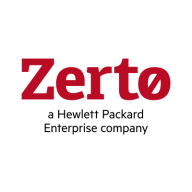

Teradata and Zerto operate in the data management and disaster recovery markets, respectively. Teradata is favored for its capabilities in complex data analysis and high-speed data processing, while Zerto excels in disaster recovery due to its near-real-time replication and rapid failover features.
Features: Teradata is designed for massive data management, providing parallel processing, advanced analytics tools, linear scalability, and robust security features, making it ideal for large-scale data warehousing. Zerto specializes in disaster recovery, offering near-real-time replication, continuous data protection, rapid failover, and seamless integration within VMware and hybrid environments. These features ensure business continuity by minimizing downtime.
Room for Improvement: Teradata could enhance its offerings by focusing on cost management, better transaction processing, and improved cloud compatibility. Adjustments in these areas could make it more competitive in cloud environments. Zerto could benefit from flexible pricing, enhanced backup functionalities, improved cloud integration, and advanced alert systems to cater to varying enterprise needs more effectively.
Ease of Deployment and Customer Service: Teradata offers flexible deployment options across various environments, but it is complex and requires specialized expertise for effective utilization. In contrast, Zerto is noted for its user-friendly setup and streamlined deployment process. Both products are recognized for their robust customer support, with Zerto particularly praised for its responsiveness and user satisfaction.
Pricing and ROI: Teradata has a high pricing structure, attractive to large enterprises seeking sophisticated data solutions, justifying notable ROI through its advanced analytics capabilities. Zerto's premium pricing aligns with its effectiveness in disaster recovery, providing a favorable ROI for companies that prioritize swift and reliable recovery operations. Both solutions represent valuable investments tailored to their respective organizational needs.
Before, it was a huge cost. It was several thousand dollars to do a DR test, whereas now, I click a button.
The return on investment is evident, as Zerto saves more than 60 percent of time in various operations compared to the previous manual processes.
Most people like me hope we never have to use it. It is like insurance.
Customer support is very good, rated eight out of ten under our essential agreement.
The technical support from Teradata is quite advanced.
I have never had an issue that was not resolved, and I have never been in a situation where they did not respond.
I would give them a rating of ten because it represents the highest level of support based on the technical knowledge of the support team, response time, and effectiveness of the provided resolutions.
When I open a ticket, I usually get a call within an hour or two.
This expansion can occur without incurring downtime or taking systems offline.
Scalability is complex as you need to purchase a license and coordinate with Teradata for additional disk space and CPU.
I would rate it a ten out of ten for scalability.
Customers need to follow good engineering practices for optimal product use.
By adding more hosts and installing VRAs on each, tasks can be efficiently managed.
I find the stability to be almost a ten out of ten.
The workload management and software maturity provide a reliable system.
I promptly delete the malfunctioning elements and set them up again to resume replication, ensuring stability.
The ease of use was so good with Zerto that they were able to migrate things much quicker.
It is very reliable.
Unlike SQL and Oracle, which have in-built replication capabilities, we don't have similar functionality with Teradata.
If I have 350 objects that I am protecting, I would like Zerto to be able to fire them up in one order, rather than having to manually bring them up in a sequence.
If the host has a lot of VMs on it, there may not always be enough time to relocate all of the VMs from a protection group standpoint to other hosts before the replication appliance that Zerto uses to manage that powers itself down.
To increase accessibility for small and medium businesses, Zerto should consider a competitive pricing strategy, possibly including subscription-based licensing options.
Teradata is much more expensive than SQL, which is well-performed and cheaper.
Initially, it may seem expensive compared to similar cloud databases, however, it offers significant value in performance, stability, and overall output once in use.
If you want a good-quality tool that is robust and does a good job for you, you have to pay a higher price to get that, and Zerto is no different.
However, it can become quite expensive when you start looking at the number of workloads you have in the environment and what you would like to do.
Zerto is easier to set up and use, and it's less expensive.
The data mover is valuable over the last two years as it allows us to achieve data replication to our disaster recovery systems.
Zerto offers excellent technical support with responsive and helpful experts.
If we were attacked, I could revert to a backup from five seconds before the attack, and no one would know we were attacked.
The replication time and the minor amount of time it takes to sync a new server outside of any of my huge 40-terabyte boxes is ridiculously quick.


Teradata is a scalable data analytics platform designed to meet enterprise demands for large-scale data management and processing, focusing on performance, scalability, and security for complex query executions.
As a leading data warehousing solution, Teradata integrates advanced analytics enabling organizations to derive insights from massive datasets. It supports high-volume data workloads with its architecture optimized for analytical queries. Users benefit from its robust scalability, allowing seamless expansion as data grows. Teradata's SQL engine is compatible with a wide range of data types, ensuring flexibility in data analysis. With advanced security measures, it protects sensitive data across various environments, providing peace of mind to users handling critical information.
What are the most important features of Teradata?Teradata is widely used in industries like finance, telecommunications, and healthcare, where data-driven decisions are critical. Companies leverage its robust analytics capabilities to enhance customer experiences, streamline operations, and ensure compliance with regulatory requirements. In these sectors, quick access to data insights can significantly impact competitive advantage.
Zerto is used for disaster recovery, business continuity, data migration, and ransomware recovery, providing continuous data protection and near real-time replication. Valued for ease of use, efficient failover processes, and versatile integration, it enhances organizational efficiency, reduces errors, and boosts productivity.
We monitor all Backup and Recovery reviews to prevent fraudulent reviews and keep review quality high. We do not post reviews by company employees or direct competitors. We validate each review for authenticity via cross-reference with LinkedIn, and personal follow-up with the reviewer when necessary.